CBR has been live-blogging the DC Nation panel at Wizard World Chicago, and reports these comments regarding the Flash. Update: Newsarama’s coverage is up, with a few more bits. I’ve tried to merge them together more-or-less in order.
“Barry Allen’s back,” a fan yelled. DiDio polled the audience to see what Flash they liked best. Jay Garrick and Bart Allen didn’t win, but Barry Allen and Wally West were both favorites.
“Flash came back and Martian Manhunter died, doesn’t that balance the scales?” [Dan] Didio said.
This is interesting phrasing, given how balance is such a central theme to Final Crisis.
– With Barry Allen back, does DC have a better plan for what to do with Barry than “what you had for Wally?”
Van Sciver: “Oh of course.”
DiDio: “Wally will be around. He’s part of the Titans team right now, and he’ll be part of that team for the foreseeable future.”
On the plus side, that again suggests that Wally West will live through Final Crisis despite Barry Allen’s return. On the minus side… who knows what they consider “foreseeable” at this point. (And they have misled us on future Flash plans before.) And it’s The Titans.
It would certainly fit with rumors that Wally may stay in the Titans while Barry rejoins the Justice League. Though it doesn’t preclude Wally staying in Justice League of America while Barry joins James Robinson’s Justice League cast with Hal, Ollie, Ray and company.
Will they bring back Bart Allen? “You have read the first issue of ‘Legion of Three Worlds,’ right?” Didio asked
, and Johns hid his head in his hands.“I haven’t read it,” [Bob] Wayne said. “It hasn’t come out.”
At that point, [Geoff] Johns put his head down and shook it, then leaned toward the microphone in front of him and said, “You’ll read it now.”
“No plans at this time,” Didio came back. “How did I cover, Geoff?”
Hmm, perhaps the carrot-dangling has officially passed from grandfather to grandson… 🙂 (This part was mashed together from both write-ups.)
Seriously, fans have been speculating as to “who was in the lightning rod” since Justice League of America #10 wrapped up The Lightning Saga a year ago. It was made clear that the Wests’ return was unintentional, but strongly implied that the Legion did manage to bring someone back. Barry? Bart? Someone else? Barry’s return in Final Crisis seems to eliminate him as a possibility, so Bart’s a strong candidate. (Looks like I’ll be adding another miniseries to my pull list this summer.)
– Any more Elseworlds? DiDio: “As a matter of fact, we have a couple in production right now… We have one story coming out from Cary Bates.”
Aside from this being big news, since they’ve been avoiding the Elseworlds name, there’s a possible Flash connection…since Cary Bates wrote Barry’s series for the better part of 15 years. Could this be a similar project to the Teen Titans Lost Annual?
– Wally’s twins? DiDio: “Montessori School,” he joked. Van Sciver: “They’re going where Nightwing’s going.”
Okaaay… I’m going to guess these were both joke answers.
– After writing Rogues Revenge, does Geoff Johns have anything else with the Flash? Johns: “Ummm… I don’t know!”
Update: There’s more Flash news from Saturday’s DCU: Crisis panel.

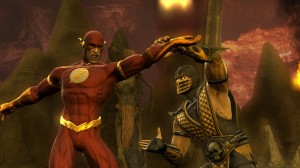
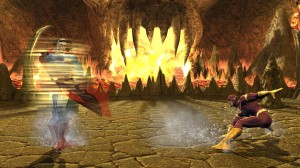
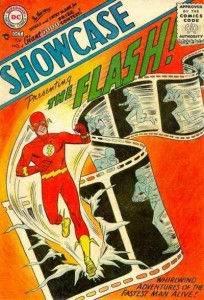 Barry made his debut in the 1956 comic book,
Barry made his debut in the 1956 comic book, 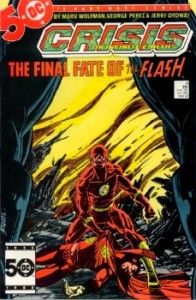
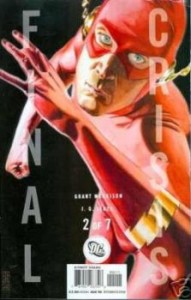 Another year later, with Final Crisis looming and continuing discontent with the relaunch, fans started to see clues that, once again, hinted at a possible return for Barry. Among those clues was a poster that appeared at the New York Comic Con that looked a lot like Barry — and was painted by J.G. Jones, the artist on Final Crisis. Then there was the summary for Final Crisis #2 and its “spectacular return from the dead.”
Another year later, with Final Crisis looming and continuing discontent with the relaunch, fans started to see clues that, once again, hinted at a possible return for Barry. Among those clues was a poster that appeared at the New York Comic Con that looked a lot like Barry — and was painted by J.G. Jones, the artist on Final Crisis. Then there was the summary for Final Crisis #2 and its “spectacular return from the dead.”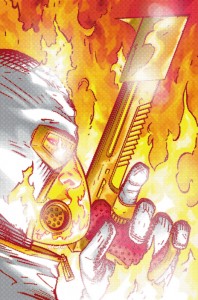 Geoff Johns and Scott Kolins have done a number of interviews about this summer’s Flash-focused mini-series, Final Crisis: Rogues’ Revenge.
Geoff Johns and Scott Kolins have done a number of interviews about this summer’s Flash-focused mini-series, Final Crisis: Rogues’ Revenge.